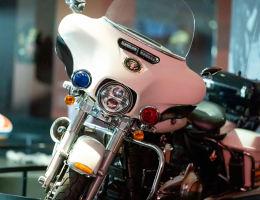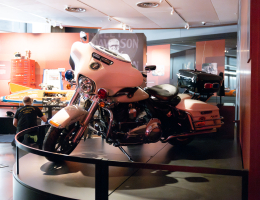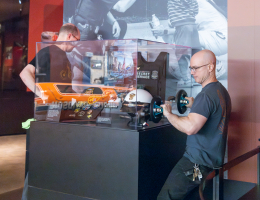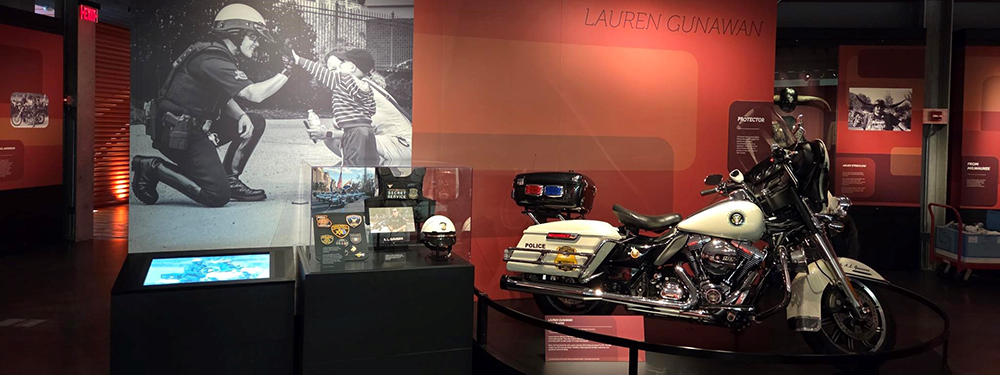
Next to Elvis Presley’s 1956 KH motorcycle and a 1970 Streamliner that once broke the world land speed record, the U.S. Secret Service has an artifact of its own greeting visitors inside the Harley-Davidson Museum in Milwaukee.
The 2016 FLHTPI, on loan from the Secret Service, has been ridden in presidential motorcades and tells the story of the Motorcade Support Unit.
“It’s a once-in-a-lifetime opportunity for the Secret Service to be featured in this nature,” said Uniformed Division Officer-Technician Lauren Gunawan, moments after seeing the exhibit for the first time. “I would love to say that this isn’t one of the biggest highlights of my life, but I’d be lying. This is 100 percent one of the biggest highlights of my life.”
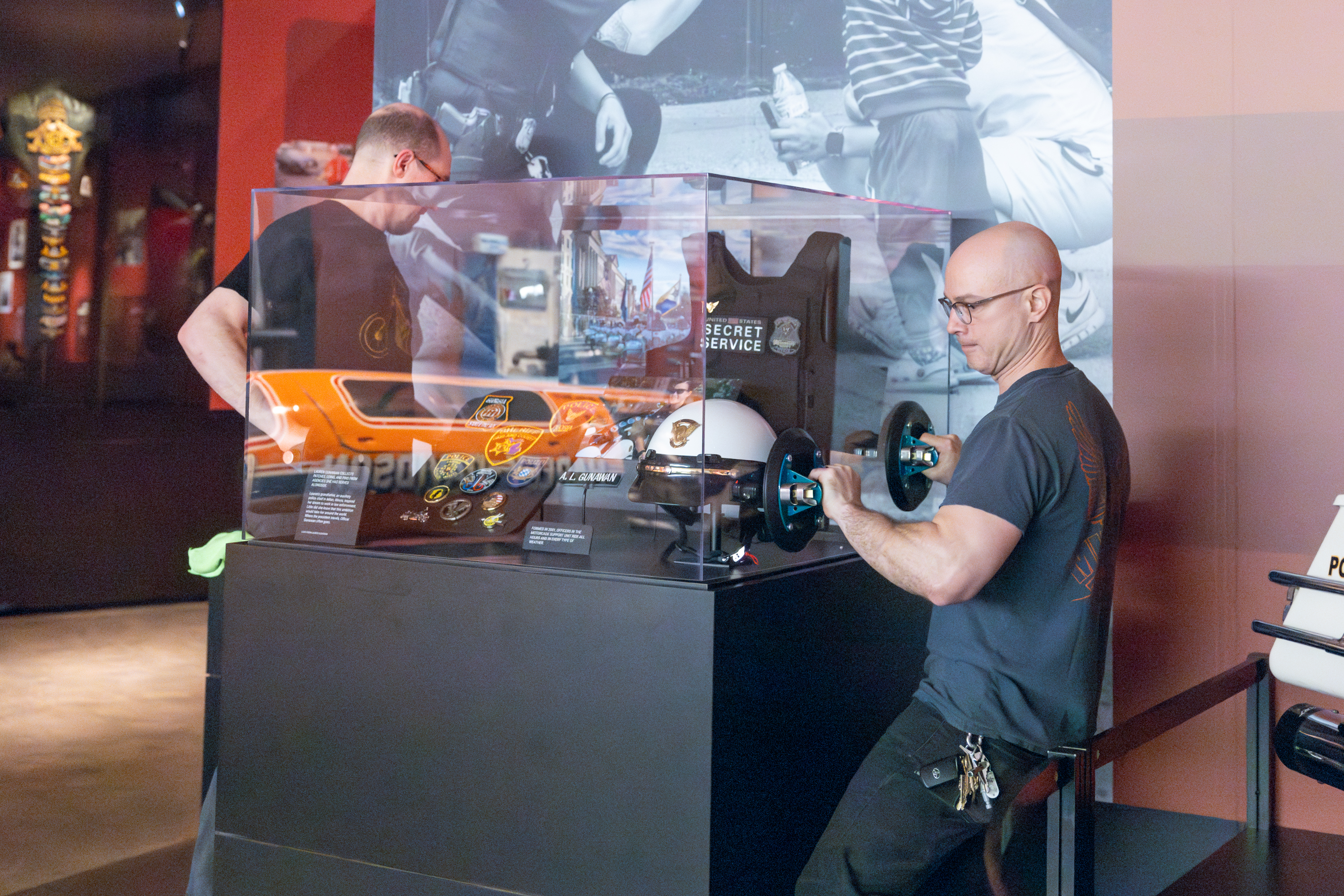
The museum’s three-year exhibit, “This is Me: Bikes, Gear, and the Stories They Tell,” opened Memorial Day weekend. It includes six motorcycles, each telling a different story.
Gunawan’s bike marks the museum’s first display featuring a federal law enforcement agency. The exhibit also includes motorcycles from Wallace Van Sandt, a Harley-Davidson enthusiast killed in World War II; J. Shia, a custom motorcycle builder who owns Madhouse Motors in Boston; and Randy “Detroit” Hayward, an educator and motorcycle racer, collector and builder.
The 1970 Streamliner, which looks like a rocket and set a record at 265.492 mph, was driven by Cal Rayborn. The exhibit honors Harley-Davidson’s legendary chief racing engineer, Dick O’Brien, who led an engineering team that included Dennis Manning and Warner Riley.
The story of the Motorcade Support Unit, known as MSU, began in 2001. The unit continues to support the Presidential Protection Division, the Vice Presidential Protection Division, the Dignitary Protection Division and all motorcade operations in the Washington, D.C., area, said Uniformed Division Chief Richard Macauley, who attended a private showing at the museum.
Macauley called the motorcycle’s entry into the Harley-Davidson Museum a “remarkable occasion” that highlights the work of the Motorcade Support Unit and the Secret Service.

“The relationship with Harley-Davidson and us debuting our Secret Service Motorcade Support Unit motorcycle today helps us with promoting the positive image of the hardworking men and women of the Secret Service,” he said. “Today is a very special day for us to be here at the Harley-Davidson Museum to honor the placement of this Secret Service decommissioned motorcycle.”
Resident Agent in Charge Angela Suzuki, of the Secret Service’s Milwaukee resident office, said the exhibit highlights female officers and agents.
“The showcase of our Uniformed Division bike is phenomenal, positive exposure for the Secret Service,” Suzuki said. “It’s a wonderful relationship between the Harley-Davidson Museum and the Secret Service.”
The motorcycle’s inclusion in the exhibit was about 18 months in the making. It started when Gunawan attended training at Harley-Davidson University’s Mechanics School, said Christopher Ripstein, vehicle archivist at the museum.
“She had asked, ‘What does it take for a vehicle to find its way into the archives?’ And I think she was genuinely asking out of curiosity, but it stuck with me and planted the seed that really resonated for a long time,” Ripstein said. “Then it pushed me to a point where I asked her, ‘What is the possibility of getting a Secret Service bike into the collection?’”
It took about 18 months to get the motorcycle on display, Ripstein said. While the museum includes military motorcycles and vehicles from other police agencies, this is the first federal law enforcement motorcycle in the collection.
“This is actually a really great acquisition for us. We have hundreds more motorcycles in our collection, and the value they bring to us is the stories they tell. The motorcycles themselves are inanimate objects. They are paint, metal, inert beings, but it is the riders who rode them that not only make the motorcycles great, but make this company and our community great,” Ripstein said.
While some law enforcement officers were riding Harley-Davidsons even earlier, the company’s first fleet orders came from Detroit and Pittsburgh in 1908, said Bill Jackson, Harley-Davidson’s manager of archives and heritage services. Today, law enforcement around the world uses Harley-Davidson motorcycles.

“The thing about military and law enforcement riders is they’re some of the most skilled riders you’re going to find in motorcycles,” Jackson said. “If you see some of the training that they have to go through, you really have to bring a next-level skill of motorcycling.”
Bill Brewster, the museum’s chief curator, said law enforcement agencies across the country ride Harley-Davidsons, which is “amazing” and a testament to the motorcycles’ reliability and functionality. But the chance of getting a motorcycle on display is “extremely low.”
“This is the first current law enforcement bike that we’ve added to the collection for an exhibit purpose probably ever. It’s an absolute thrill for us,” Brewster said. “The fact that we can bring representation of the government into the museum and show that that relationship exists, it’s just priceless.”
David Kreidler, the museum’s senior exhibits curator, said the exhibit explores how particular riders express themselves through their riding.
“Let’s talk about these people who build these bikes or ride these bikes — why they ride these bikes. And the thing that I’ve appreciated, when you talk to so many different people from so many different backgrounds, is that even if they’re all Harley riders, which is the case in this exhibit, they all do it in a different way,” Kreidler said. “They might talk the same language, but they are doing it in really unique ways to themselves.”

